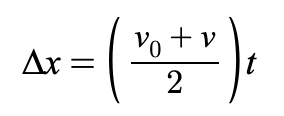Physics Enrichment | Formula List
Variables
V = vector
Vx = horizontal component of a vector
Vy = vertical component of a vector
R = magnitude of resultant vector
Rx = horizontal component of a resultant vector
Ry = vertical component of a resultant vector
δ = angle of resultant vector
∆x = horizontal displacement
∆y = vertical displacement (for free-fall, can also be represented by d)
x0/xi = initial position
x/xf = final position
∆t = change in time
t0/ti = initial time
t/tf = final time
vavg = average velocity
∆v = change in velocity
v0/vi = initial velocity
v/vf = final velocity
a = acceleration
g = gravity = -9.8 m/s²
Equations for Variables
Displacement

Change in Time

Average Velocity

Change in Velocity

Acceleration

Finding Components of a Vector (V)
Horizontal Component
Vx = |V| • cos(ϴ)
Vertical Component
Vy = |V| • sin(ϴ)
Resultant Vector
Component Form of a Vector
V = Vx^i + Vy^j
^i is the unit vector along the x-axis.
^j is the unit vector along the y-axis.
Adding Components
Rx = ∑ Vx (add the horizontal or x-components of all individual vectors)
Ry = ∑ Vy (add the vertical or y-components of all individual vectors)
Magnitude of the Resultant vector
R = √Rx2 + Ry2
Angle of the Resultant Vector
δ = tan-1 (Ry/Rx)
Kinematics Equations
Equation 1
describes how velocity changes over time when acceleration is constant

Equation 2
describes the position of an object at any time, considering both initial velocity and acceleration

Equation 3
relates velocity and displacement without time

Equation 4
describes position based on average velocity

Free Fall Equations


